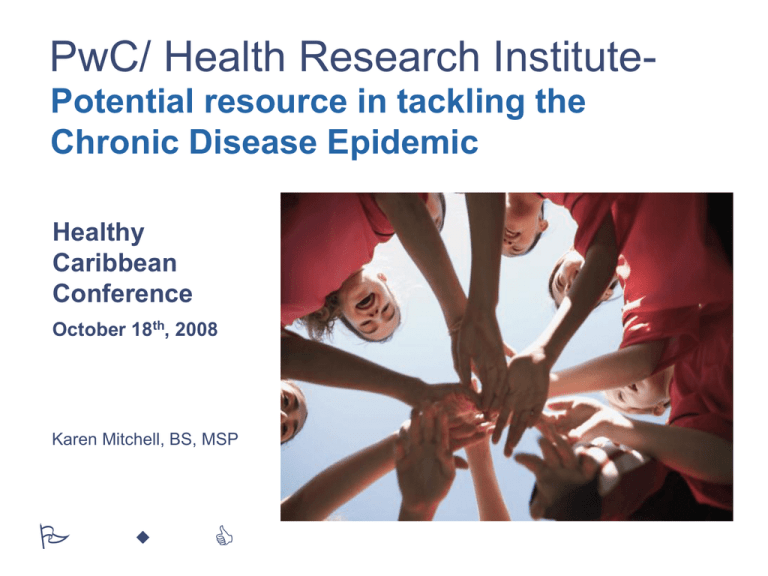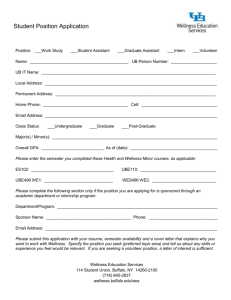
PwC/ Health Research InstitutePotential resource in tackling the
Chronic Disease Epidemic
Healthy
Caribbean
Conference
October 18th, 2008
Karen Mitchell, BS, MSP
Agenda/Contents
• PwC/ Health Research Institute (HRI)
• World Economic Forum (WEF)
• Economic Rationale for Health and Wellness
- Healthcare costs
- Productivity
- Human Capital
- Sustainability
• Potential Gaps and Solutions
• Global examples
• PwC/HRI Approach
PwC/ Health Research Institute (HRI)
• Dedicated global healthcare research
- leading-edge intelligence, perspective, and analysis
- supports decision-making and strategy development for the
private and public sector
- leverages diverse PwC experience and background within the
health industries
• Publications are used by
- policy makers
- business
- healthcare thought-leaders
- major media e.g. CNN
• Strategic partner with the World Economic Forum
- implement strategies to promote workplace wellness and stem
the tide of chronic disease.
- particular focus on developing countries
PricewaterhouseCoopers
Slide 3
WEF Working Towards Wellness 2007-2008
Global leaders’ deeper
engagement with the
wellness issue
1
WHO/Forum joint report
• Create shared recommendations on
how to create and stimulate effective
workplace wellness programmes in the
goal of preventing chronic disease
globally
Technical
and
academic
perspective
2
The Business and
Medical Rationale
• Demonstrate the
quantifiable potential
economic savings at
national and
business level and
the logic behind
PricewaterhouseCoopers
3
Global examples
• Highlight 3-4 existing
examples of
programmes
targeting key risk
factors in developing
world
4
Measurement
• Outline examples of
current systems
used globally to
measure employee
health and propose
a best practice
measurement
framework
5
Practical steps
• Lay out an example
of “how to”, the
lessons learned and
subsequent
proposals for
stakeholders
Business
perspective
Slide 4
Economic Case for Wellness
Healthcare Costs
•
•
Chronic disease which is largely
preventable is increasing burden on
individuals and social programmes
- Impact on health systems, taxes
and costs of coverage
The risk factors that lead to chronic
disease are cumulative, as are the
costs associated with them.
- Metabolic syndrome, which
includes a combination of
obesity and other health risks, is
associated with a two to nine
times higher prevalence of
chronic diseases.
In the US, people with chronic
disease account for more than 75%
of the nation’s US$ 2 trillion in
medical spending.
$9,000
Healthcare Cost in 2008
•
Est. 2008 US Healthcare Costs
by Number of Health Risks
$7,587
$8,000
Excess Costs
$7,000
Base Healthcare Cost
$6,000
$5,000
$4,756
$4,000
$1,733
$4,565
$3,000
$2,000
$3,022
$3,022
$3,022
Low Risk
Medium Risk
High Risk
$1,000
$0
Source: PricewaterhouseCoopers projection of Edington Excess Health
Costs 2003, personal communication
Co-Morbidities
Diabetes
Coronary artery
disease
Hypertension
Stroke
Prevalence
Metabolic
Syndrome
18%
Non-Metabolic
Syndrome
2%
15%
48%
2%
4%
13%
1%
Source: “Metabolic Syndrome and Employer-Sponsored Medical Benefit:
An Actuarial Analysis”, Kathryn Fitch et al, Milliman, March 2006
Source: PricewaterhouseCoopers 2008 - World Economic Forum Working Towards Wellness Business Rationale
PricewaterhouseCoopers
Slide 5
Economic Case for Wellness
•
•
•
•
Productivity losses associated
with poor health risks are as
much as 400% of cost of treating
chronic disease.
Includes unplanned absences,
reduced workplace
effectiveness, increased
accidents and negative impacts
on work quality or customer
service.
Studies show that multiple health
risk factors multiply the losses in
productivity
Stress and depression are
intertwined with work & life
environmental factors in
impacting human capital
effectiveness
Lost Productivity Related to Health Risks
40.0%
Base Productivity
Incremental Cost
34.5%
35.0%
Millions of deaths
Productivity
30.0%
25.4%
25.0%
17.4%
8.3%
20.0%
15.0%
10.0%
17.1%
17.1%
17.1%
Low Risk
Medium Risk
High Risk
5.0%
0.0%
Source: PricewaterhouseCoopers synthesis and the projections of Burton, Edington et al, JOEM
47(8); Tsai et al, JOEM 47(8); and Yen, private communication, HMRC 2001
Costs Associated with Health Risk
Medical &
Pharmacy
Presenteeism
Absenteeism
Short-Term
Disability
Long-Term
Disability
Source: “A Practical Approach to Occupational and Environmental Medicine,” by Dee Edington and
Wayne Burton, in Health and Productivity, by Robert J. McCunney, Little, Brown,2003
Source: PricewaterhouseCoopers 2008 - World Economic Forum Working Towards Wellness Business Rationale
PricewaterhouseCoopers
Slide 6
Economic Case for Wellness
Human Capital
•
•
Organizations invest an average of $290
in labour costs to generate $1,000 in
revenue.
- Helping employees work longer and
have more productive lives, can
protect this asset in the face of
growing labour shortages globally.
- An organization that shows that it
values its workers is more likely to
attract, retain and motivate
employees.
The demand for talented people is
increasing, and an ageing workforce is
creating an additional drain on
organizations’ workforces.
- Health & wellness is helping some
organization distinguish themselves
as employers of choice.
“FedEx Mexico has
distinguished itself as the
“best place to work” in Latin
America. It utilizes its
workplace wellness efforts to
help communicate and
reinforce its People First
philosophy with its
employees.”
Source: PricewaterhouseCoopers 2008 - World Economic Forum Working Towards Wellness Business Rationale
PricewaterhouseCoopers
Slide 7
Economic Case for Wellness
Sustainability
• The epidemic of chronic disease is as equally prevalent and preventable as issues such as
global warming, infectious diseases, poverty, terrorism, clean water and basic infrastructure.
• As the economic burden of chronic disease grows, it could crowd out monies needed to
improve other critical issues such as education and infrastructure.
Condition / Issue
1
Asthma
3
Cancer
3
Cardiovascular Disease
Chronic Obstructive Pulmonary Disease (COPD)
Diabetes
Selected Chronic Conditions
HIV/AIDS
Global Warming Health Issues
Current
Impacted
(thousands)
2
Current Deaths
(thousands)
Projected Deaths in
2030 (thousands)
300,000
277,400
638,750
80,000
180,000
1,476,150
255
7,600
17,500
3,000
1,100
29,455
360
11,400
23,300
5,700
2,200
42,960
39,500
2,900
6,500
5,500
166
332
(1) Source: World Health Organization, http://w w w .w ho.int/mediacentre/factsheets/en
(2) Current year refers to 2005 for all conditions and 2006 for HIV/AIDS.
(3) Projected impacted numbers estimated based on the average multiplier of chronic diseases
Source: PricewaterhouseCoopers 2008 - World Economic Forum Working Towards Wellness Business Rationale
PricewaterhouseCoopers
Slide 8
Working Towards Wellness
Potential Gaps and Solutions
Potential Gaps
-
-
-
Lack of incentives for
“upstream” behavior
Lack of data liquidity
Lack of common definitions
and standards
Clinicians not viewed as
partners.
Poor environmental factors
Lack of consideration of
genetics
Lack of partnership between the
private and public sector
Fragmentation of the current
infrastructure.
PricewaterhouseCoopers
Proposed Solutions
-
Invest in public health and
education
Reorient care delivery
Empower and activate
patients
Establish Leadership
Conduct research
Create Metrics and Goals
Create an information
infrastructure
Redesign Incentives
Slide 9
Working Towards Wellness
Global Examples
• World Economic Forum (Case Studies)
Brazil, Dow Chemical
South Africa, Eskom Holdings
South Africa, Discovery
Singapore, Becton Dickinson and Company
• PricewaterhouseCoopers (Case Studies)
State Government, Victoria, Australia
Department of Work and Pensions, United Kingdom
Multi-industry Holding Company, Dubai
Center for Disease Control, United States
PricewaterhouseCoopers
Slide 10
Working Towards Wellness
The Path to a Healthy and Productive Nation
People are the cornerstone to a nation's success. Building and sustaining a
culture of health and wellness reaps many rewards for a country and its
people.
Today
Tomorrow
• Lost productivity affects
global competitiveness
• Build and maintain a high
performing workforce
• Spiraling health costs
burden societies
• Align incentives and
resources supporting
culture of health and
wellness
• Lack of data liquidity
• Poor universal
standards for health and
wellness
Develop
People and
Health
Strategy
Deploy
Resources and
Support
Sustain a
Healthy
Culture
• Lack of incentives for
improved behavior
• Improve productivity and
functionality
• Improve health and
reduce burden of health
costs
• Lack of partnership
between the private and
public sectors.
Defining the Strategy / Executing and Sustaining the Solution
PricewaterhouseCoopers
Slide 11
Working Towards Wellness
PwC/ HRI Approach
Analyze Current Opportunity
• Evaluate health and well
being in the context of the
socio-economic factors,
culture and sustainability
• Inventory and audit current
programs related to health
and vitality
• Include full spectrum of
offerings from all areas
• Integration points
• Outcomes
• Successes, failures
• Cost, return
• Monitoring
• Profile population
• HRQ data or model
based on demographics
• Claims
• Healthy/at risk
• Chronic
• Acute/catastrophic
• Report on assessment
Develop Design Strategy
• Engage stakeholders
• Develop short and longterm strategies
• Establish
communication strategy
• For each intervention,
• Assess opportunities
based on culture and
population
determine build, buy or
collaborate
Assess and Improve
• Establish periodic
reporting and oversight
• Review metrics including:
• Participant
engagement
• Assess capabilities
• Determine priorities
• Evaluate potential
• Identify appropriate
interventions
• Design change and
communication
strategies
• Establish multi year plan
and objectives
• Determine
accountabilities of
stakeholders at each
level
• Validate strategy
PricewaterhouseCoopers
Implement and Support
partners & best
practices
• Population health
improvements
• Costs, gaps and
opportunities
• Formalize sourcing
as appropriate
• Implement
interventions, manage
key touch points and
establish metrics
• Absence and
productivity
• Intervention
participation rates and
impact
• Engage, communicate
and educate across the
community
• Benchmark against
emerging and best
practices
• Manage and coordinate
implementation efforts
• Modify, Refine and
Streamline
Slide 12
Karen Mitchell, BS, MSP
300 Madison Avenue,
New York, NY 10017.
mitchell.karen@us.pwc.com
Phone: 646-471-8377
© 2008 PricewaterhouseCoopers LLP. All rights reserved. "PricewaterhouseCoopers" refers to
PricewaterhouseCoopers LLP (a Delaware limited liability partnership) or, as the context requires, other member
firms of PricewaterhouseCoopers International Ltd., each of which is a separate and independent legal entity.
*connectedthinking is a trademark of PricewaterhouseCoopers LLP.
PwC









